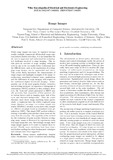- CERES Home
- →
- Cranfield Defence and Security
- →
- Staff publications (CDS)
- →
- View Item
JavaScript is disabled for your browser. Some features of this site may not work without it.
| dc.contributor.author | Liu, Yonghuai | |
| dc.contributor.author | Yuen, Peter W. T. | |
| dc.contributor.author | Pang, Yanwei | |
| dc.contributor.author | Zhao, Yitian | |
| dc.contributor.author | Rosin, Paul L. | |
| dc.date.accessioned | 2019-06-26T12:50:07Z | |
| dc.date.available | 2019-06-26T12:50:07Z | |
| dc.date.issued | 2019-05-10 | |
| dc.identifier.citation | Liu Y, Yuen P, Pang Y, et al., Range images, In: Wiley Encyclopedia of Electrical and Electronics Engineering | en_UK |
| dc.identifier.isbn | 9780471346081 | |
| dc.identifier.uri | https://doi.org/10.1002/047134608X.W5516.pub2 | |
| dc.identifier.uri | http://dspace.lib.cranfield.ac.uk/handle/1826/14266 | |
| dc.identifier.uri | https://doi.org/10.1002/047134608X | |
| dc.description.abstract | This article gives an overview of range‐imaging techniques with an aim to let the reader better understand how the difficult issue, such as the registration of overlapping range images, can be approached and solved. It firstly introduces the characteristics of range images and highlights examples of 3D image visualizations, associated technical issues, applications, and the differences of range imaging with respect to the traditional digital broadband imaging. Subsequently, one of the most popular feature extraction and matching methods, the signature of histograms of orientations (SHOT) method, is then outlined. However, the “matched” points generated by SHOT usually generate high proportion of false positives due to various factors such as imaging noise, lack of features, and cluttered backgrounds. Thus, the article discusses more about image‐matching issues, particularly to emphasize how the widely employed range image alignment technique, the random sample consensus (RANSAC) method, is compared with a simple, yet effective, technique based on normalized error penalization (NEP). This simple NEP method utilizes a strategy to penalize point matches whose errors are far away from the majority. The capability of the method for the evaluation of point matches between overlapping range images is illustrated by experiments using real range image data sets. Interestingly enough, these range images appear to be easier to register than expected. Finally, some conclusions have been drawn and further readings for other fundamental techniques and concepts have been suggested. | en_UK |
| dc.language.iso | en | en_UK |
| dc.publisher | Wiley | en_UK |
| dc.rights | Attribution-NonCommercial 4.0 International | * |
| dc.rights.uri | http://creativecommons.org/licenses/by-nc/4.0/ | * |
| dc.subject | education | en_UK |
| dc.subject | historical background of fields in electrical and electronics engineering | en_UK |
| dc.subject | patents | en_UK |
| dc.subject | technology and society | en_UK |
| dc.subject | computer and software engineering | en_UK |
| dc.title | Range images | en_UK |
| dc.type | Book chapter | en_UK |
Files in this item
The following license files are associated with this item:
This item appears in the following Collection(s)
-
Staff publications (CDS) [1209]

